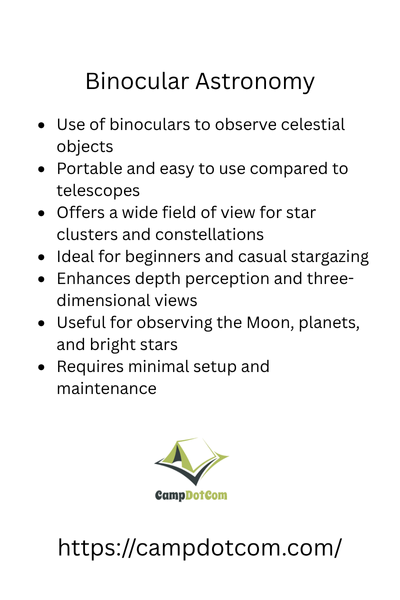If you have ever found yourself gazing up at the night sky, marveling at the stars, planets, or maybe the moon, you have likely thought about how you can see more, how you can get closer to those celestial bodies. That is where binocular astronomy comes in. It is an incredibly exciting hobby that brings the universe right into your hands, and it is a lot easier than you might think.
Read More About Binocular Astronomy

Why Binocular Astronomy is a Great Start
Let me tell you something personal: I remember the first time I got a pair of binoculars to explore the night sky. It was a bit of a spontaneous decision—I’d always been fascinated by the stars, but I didn’t want to dive straight into buying a big telescope just yet.
A friend recommended binoculars, and after a quick search online, I was holding my first pair of “sky glasses.”
As an Amazon Associate, I earn from qualifying purchases. Some of the links in this article are affiliate links. This means that, at zero cost to you, I will earn an affiliate commission if you click through the link and finalize a purchase.
You wouldn’t believe how much clearer and more exciting the sky looked through those lenses! I could see craters on the moon, the four largest moons of Jupiter, and even some of the brighter stars in distant constellations. Honestly, I couldn’t get enough, and that moment completely changed how I looked at the sky.
More Things to Know About Binocular Astronomy

If you’re new to astronomy, binoculars are one of the easiest and most accessible tools to get started. You don’t need a fancy telescope, and you certainly don’t need to be a seasoned expert.
Binocular astronomy is perfect for beginners because it gives you a wide, stable view of the sky and lets you explore at your own pace without the steep learning curve that often comes with other equipment.
What You Can See with Binoculars
Let’s talk about what you can actually see with binoculars. You might be surprised at how much you can spot with just a pair of binoculars and a clear night sky.
The Moon
One of the most spectacular sights you’ll see through binoculars is the moon. Forget the blurry, tiny disc you see with the naked eye—binoculars allow you to zoom in and get a detailed view of its craters, valleys, and mountain ranges. You can easily spot the major lunar features, like the Sea of Tranquility or the Tycho crater, with the right pair of binoculars.
Planets
Planets are another favorite target for binocular astronomers. While you won’t get detailed images like you would with a telescope, you can still spot several planets in our solar system.
Jupiter is an easy target, and through binoculars, you’ll likely spot its four largest moons: Io, Europa, Ganymede, and Callisto.
Saturn’s rings are a bit of a stretch for binoculars, but with a steady hand and the right equipment, you might catch a glimpse of them.
Stars and Constellations
Binoculars are also great for observing stars and constellations. You’ll be able to see star clusters, such as the Pleiades (or Seven Sisters), and witness how beautiful the sky looks when you get a broader view than what your naked eye can catch.
Deep-Sky Objects
Some deep-sky objects, like galaxies or nebulae, are visible with binoculars, though they can be a bit more challenging to spot. The Orion Nebula is a popular target, and you might even be able to catch the Andromeda Galaxy under dark skies. I can remember the thrill of spotting the Andromeda Galaxy for the first time—it’s just one of those moments that sticks with you.
Choosing the Right Binoculars for Astronomy
You’re probably wondering, “What kind of binoculars do I need to get started?” It’s actually simpler than it sounds.
For astronomy, you’ll want binoculars that offer a decent magnification and a wide field of view. Generally, binoculars with a magnification of 7x to 10x are ideal. You don’t want anything too powerful—higher magnification can make it harder to hold steady and get a clear image.
Also, look for binoculars with a larger objective lens (the front lens)—this will allow more light into the binoculars, giving you a brighter and clearer view of the night sky.
I’d recommend going for binoculars with at least an aperture of 50mm. These will allow you to gather enough light to see fainter objects, but won’t break the bank or be too bulky.
Tips for Getting the Best Views
Here are a few tips to help you get the most out of your binocular astronomy experience:
- Stabilize Your View: A steady hand is key when using binoculars. If you find it tricky to hold them still, consider using a tripod mount specifically designed for binoculars. This will help you avoid the shaky views that often come with handheld use.
- Pick the Right Time: The best time to view the night sky is when it’s dark, of course! Avoid light pollution by heading to a location away from city lights. Plus, make sure you’re observing on a clear night with minimal clouds.
- Learn a Few Constellations: Familiarizing yourself with a few constellations, like Orion or Ursa Major, can make it easier to find objects in the sky. Apps like Stellarium or SkySafari are great tools for beginners.
- Be Patient: Astronomy is a hobby that rewards patience. Sometimes, you’ll have to search for a while to spot that one object you’re after. But when you do find it, the thrill is all the more exciting.
Binocular Astronomy is a Gateway to the Universe
If you’re just getting into astronomy or looking for an affordable way to start exploring the night sky, binoculars are the perfect choice. The accessibility and ease of use they offer make them a fantastic way to experience the cosmos—whether you’re peering at the craters on the moon or trying to spot a distant galaxy.
So, next time you look up at the sky, imagine the wonders that binocular astronomy can reveal to you. It’s a hobby that’s waiting to be explored, and I’m sure you’ll love it as much as I do.
If you’re ready to dive into the night sky, grab a pair of binoculars, and enjoy the adventure.
